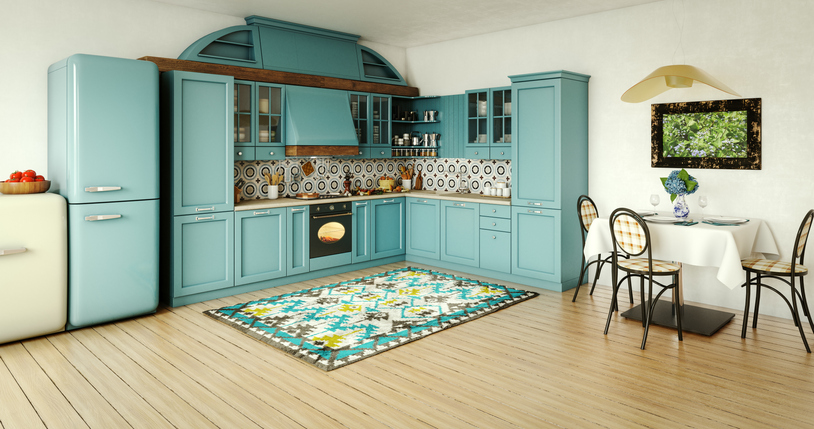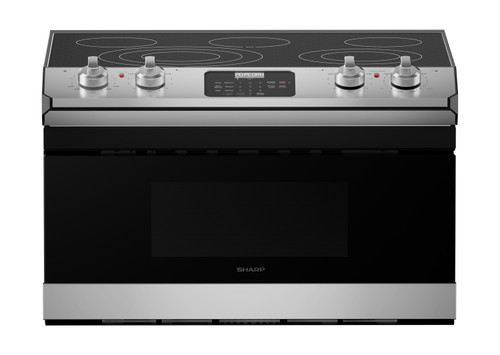

We may earn revenue from the products available on this page and participate in affiliate programs. Learn More ›
Kitchens are a known gathering place. Between conversations at the kitchen island, baking cookies with loved ones, and preparing delicious meals, kitchens bring a lot of foot traffic. However, people aren’t the only ones congregating in the kitchen.
Look at what’s occupying your countertop, cupboard, and pantry real estate. Stand mixers, toasters, blenders, microwaves, coffee machines, and smart appliances fill the seemingly endless list of kitchen appliances. Rather than let these tools overwhelm your kitchen, use one of these seven ways to disguise their presence.
1. Use contact paper or vinyl.

Contact paper and removable vinyl offer an excellent way to conceal appliances—especially if you are afraid to commit to a particular aesthetic long term. There are lots of options available for color and finish, including stainless steel and other metallics. You can even find contact paper in different finishes, like this Livelynine matte black peel-and-stick paper at Amazon. Cover the face of your appliances, such as your dishwasher, fridge, stove, and more, helping them blend in with your kitchen’s style.
Read the manufacturer’s instructions and test out a small patch of contact paper or vinyl to ensure it will hold up for a specific appliance. Apply the contact paper smoothly, avoiding air bubbles or folding the material for the best finish.
RELATED: I Transformed My Living Space Without Picking Up a Paint Brush Thanks to This Easy-to-Use Product
2. Create an appliance garage.

How many small appliances call your countertop home? Between your well-loved rice cooker, air fryer, and all the other devices, essential space for chopping, seasoning, and plating is gradually fading away.
Rather than cook in a cramped corner or deal with the cluttered appearance, create an appliance garage. This vintage kitchen cabinet is making a comeback. The appliance garage blends in seamlessly and often lifts open like a garage or pull-down door, concealing the appliances you use frequently—so they’re still easy to access. Consider a countertop appliance garage if you don’t want to make any major kitchen changes.
RELATED: Why Every Kitchen Needs an Appliance Garage—and 13 Stylish Organizational Ideas
3. Hide large appliances within your kitchen cupboards.

Perhaps the most impressive way to disguise your large kitchen appliances is by hiding them within custom cabinets. You’ve likely seen this look on a home design show where the host opens a large cupboard door that actually turns out to be the fridge.
There are generally two ways to accomplish this aesthetic. You can either create custom cabinet boxes for them or ask a cabinet maker to create the front panels and insert them to disguise your larger appliances. Flatter appliances work better, and be sure to add panels carefully to avoid damaging the appliance.
RELATED: The Best Kitchen Cabinets
4. Paint the appliance’s exterior.

Painting is an easy way to refresh older appliances and help them blend in better with your kitchen. Not just any product will do; be sure to select paint designed for appliances, typically a good quality epoxy appliance paint like Rust-Oleum appliance spray paint.
DIYers can accomplish this task by removing the hardware, cleaning the appliance thoroughly, roughing up the surface (helping the paint adhere better), and doing a small test patch. Once the entire appliance has been painted and dried, replace the hardware.
RELATED: How To: Paint Stainless Steel
5. Install an appliance lift for your mixer.

Baking aficionados, this one’s for you. If your heavy stand mixer needs a permanent place in the kitchen, but space is at a premium, an appliance lift keeps it accessible and stores it away after each use without straining your muscles. The mixer stays on a platform that glides out of a standard cabinet and up to counter height using a bracket system, such as this Hardware Resources soft close appliance lift from Amazon.
6. Consider dual-purpose appliances.

If you are in the market for new appliances, dual-purpose devices are a space saver and may not require a disguise at all. Items like Sharp’s Smart Radiant Rangetop with Microwave Drawer Oven combine two valuable appliances. Microwaves, in particular, can be bulky space hogs on a countertop. This combo unit reduces the number of appliance units you need, lessens clutter, and might free up a convenient space in the kitchen.
7. Relocate lesser-used appliances.

Be honest: Do you need all of your appliances within arms’ reach at all times? It isn’t very likely.
If you can’t bear the thought of parting with an espresso machine you use only in the cold months, you don’t have to get rid of it or find a creative way to hide it. Instead, tuck the machine away in a pantry or less convenient cupboard until you need it. Keeping lesser-used appliances out of sight can help streamline your kitchen immensely.
RELATED: These Cabinet Customizations are Totally Worth It, According to Pro Organizers
